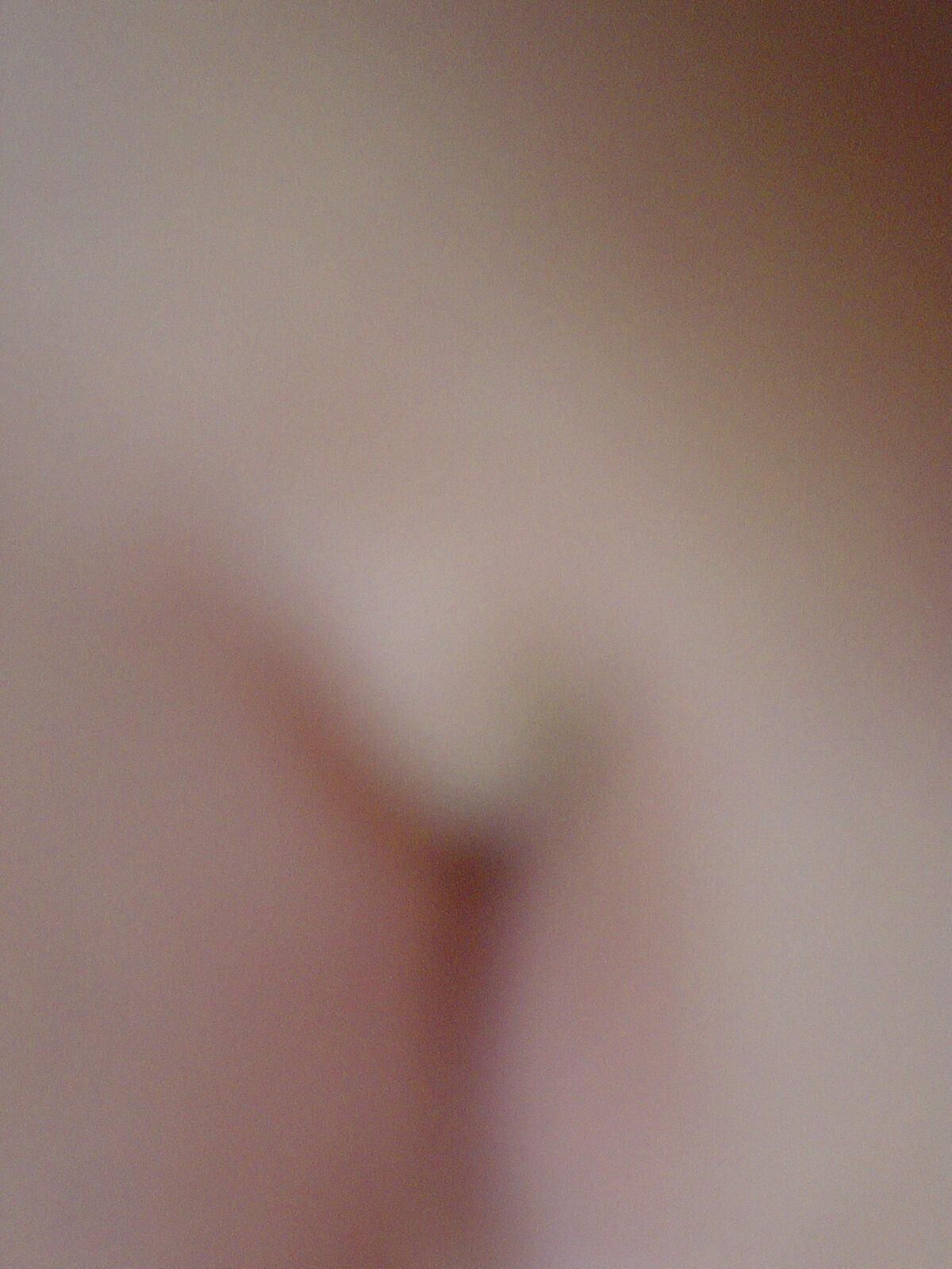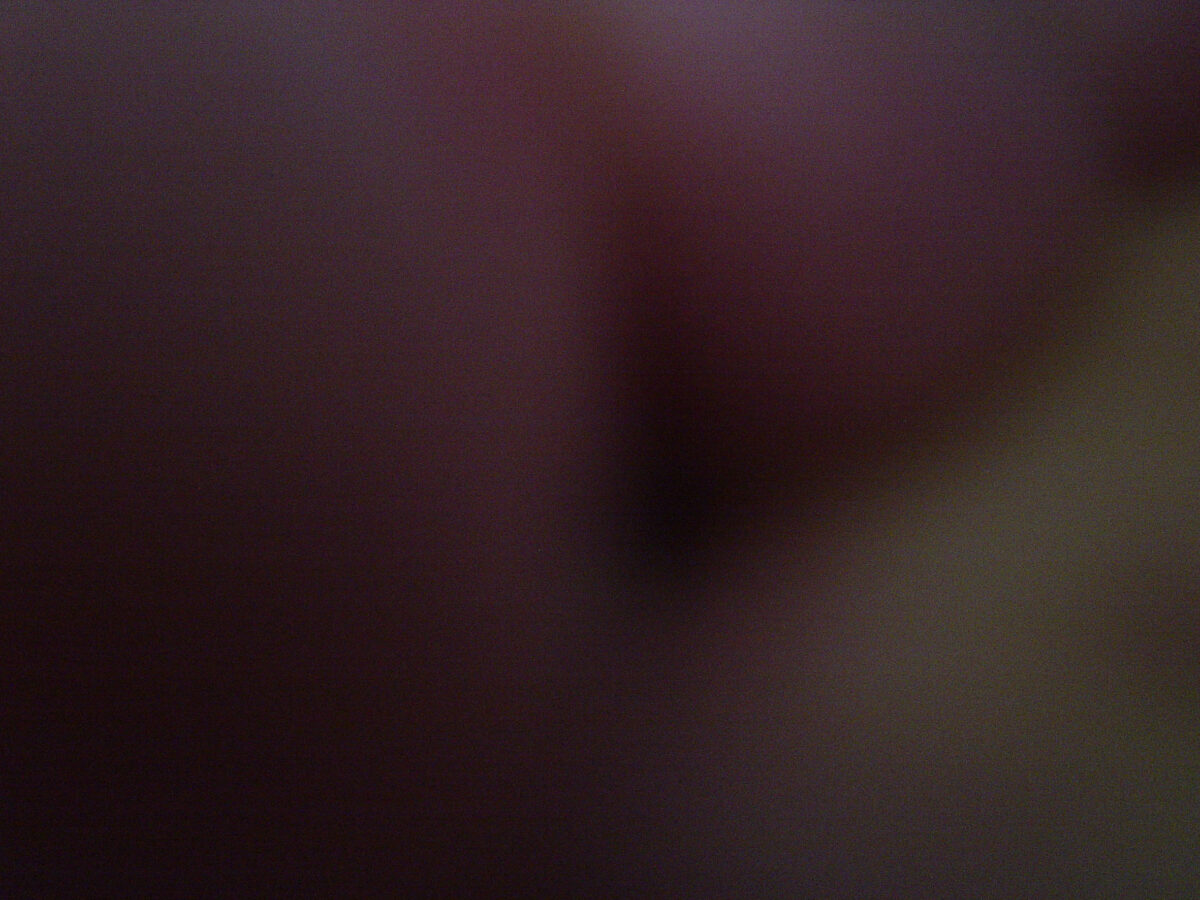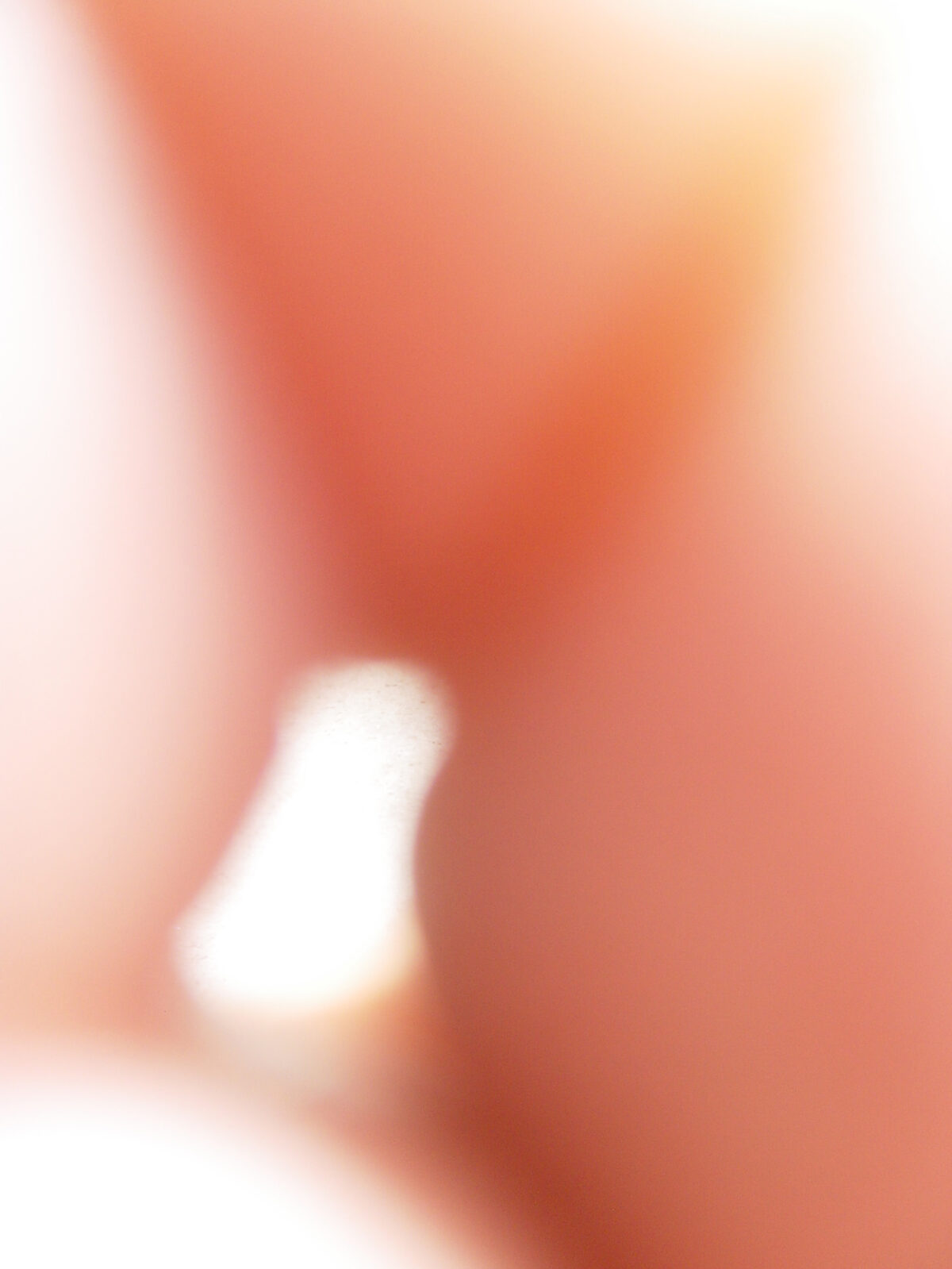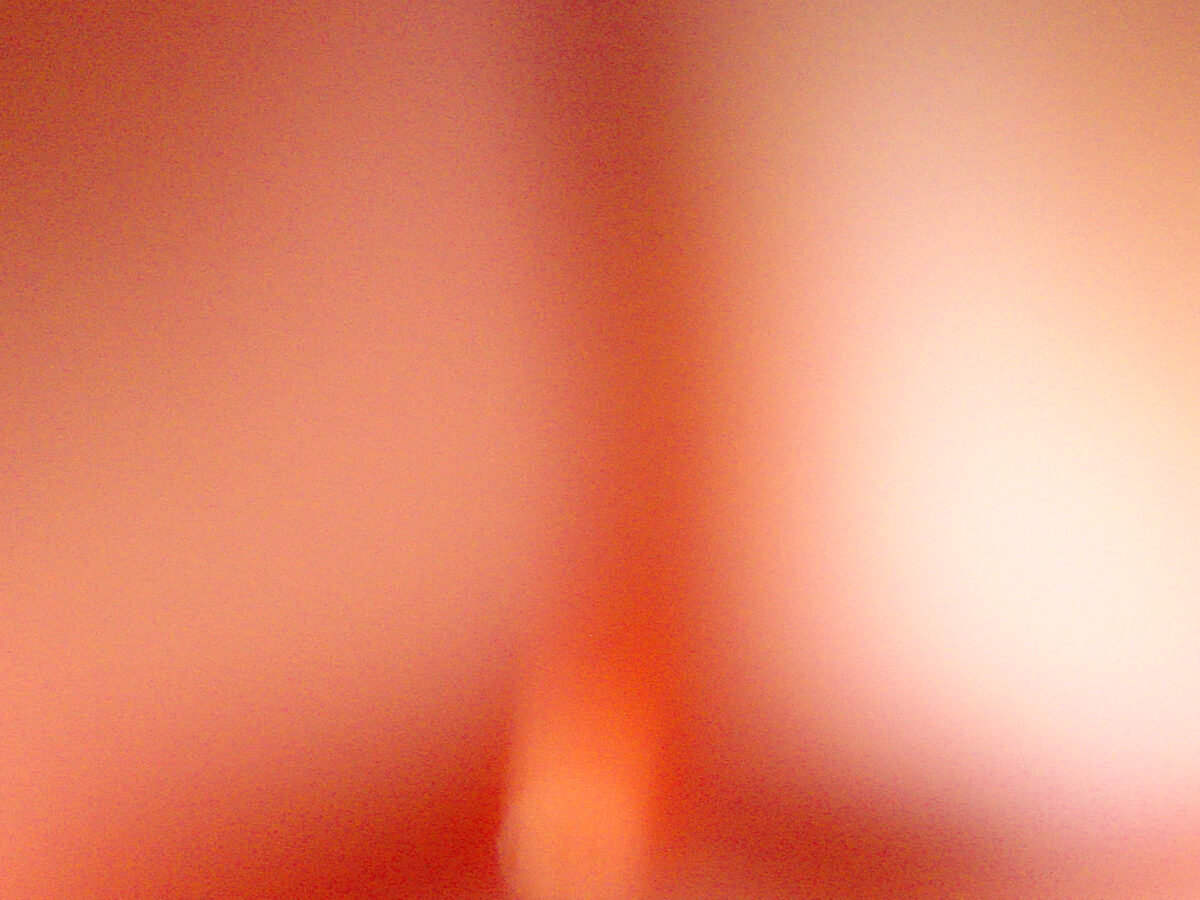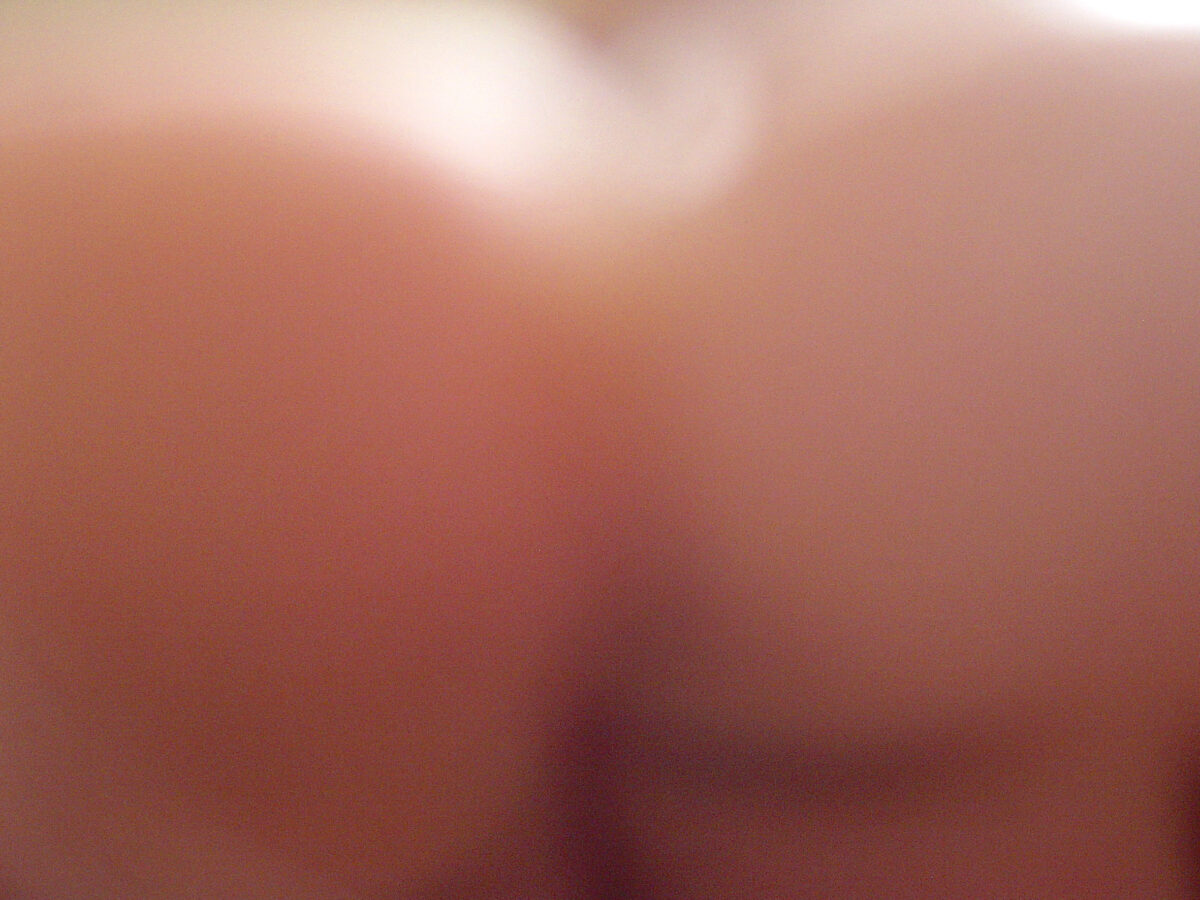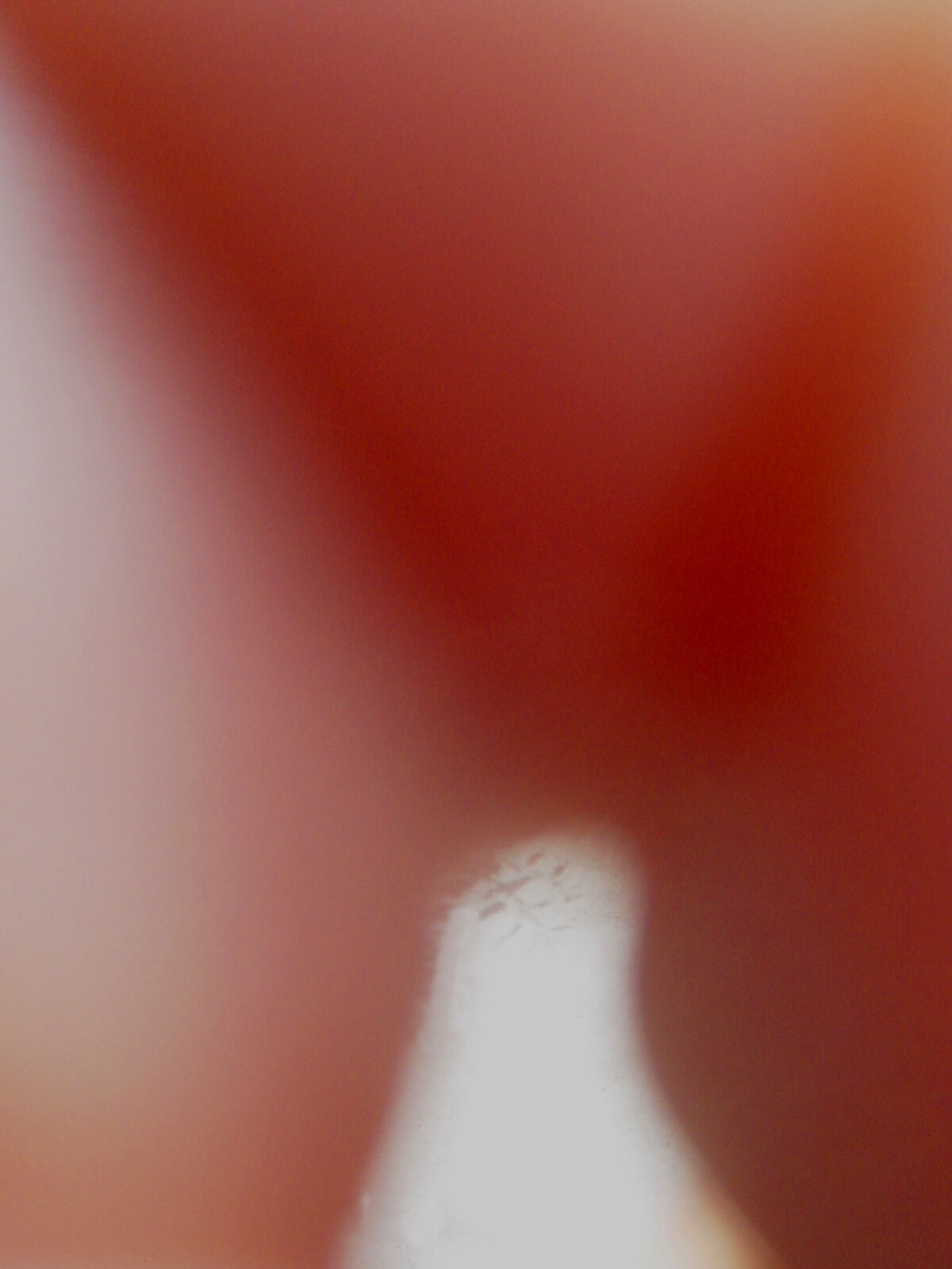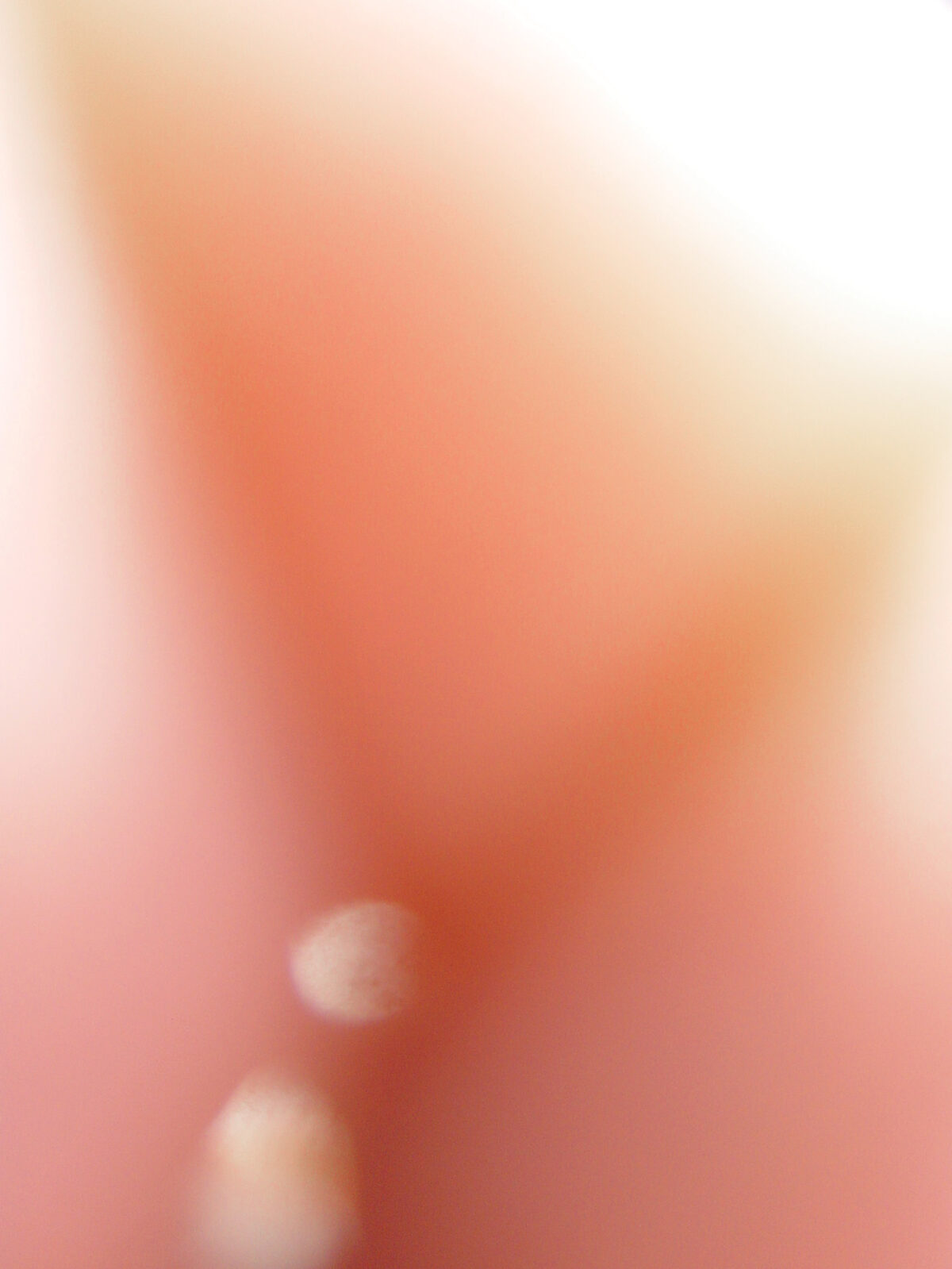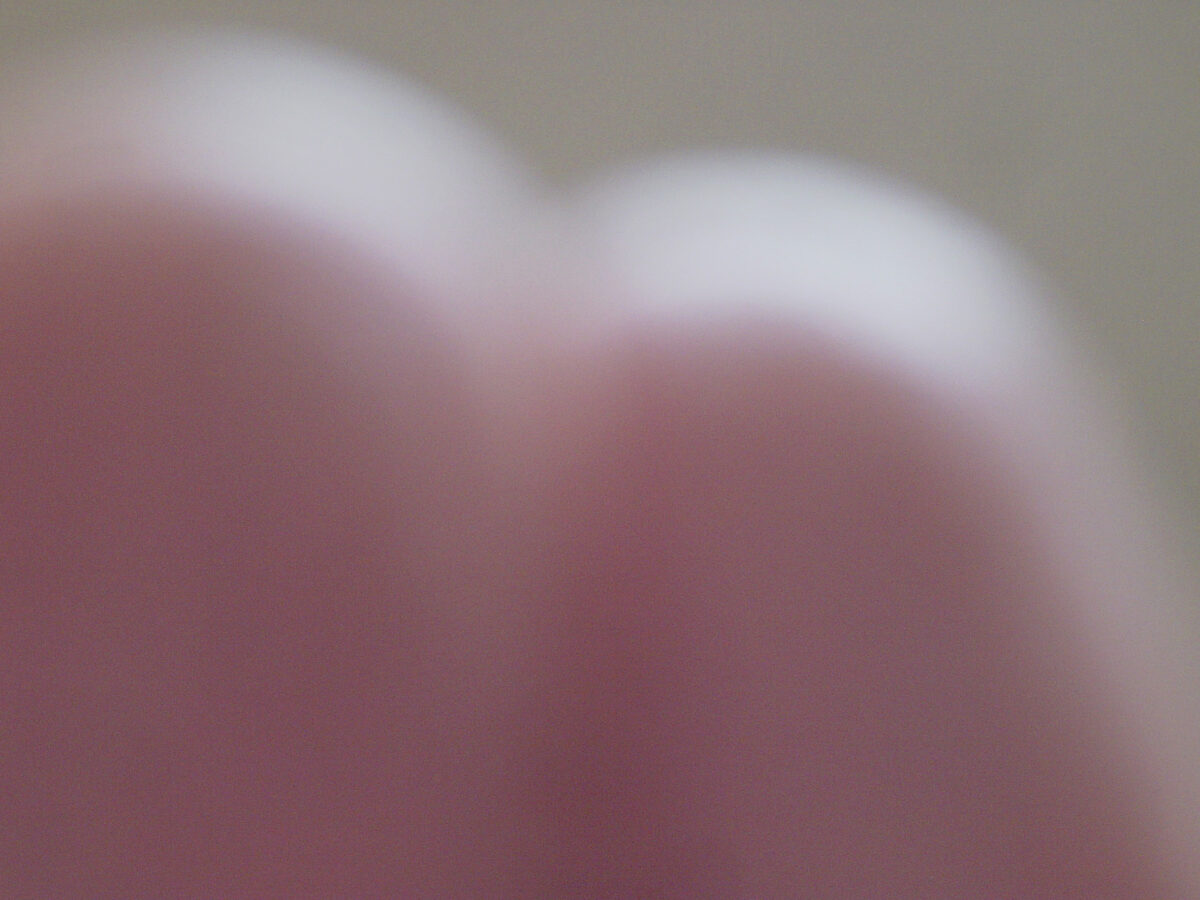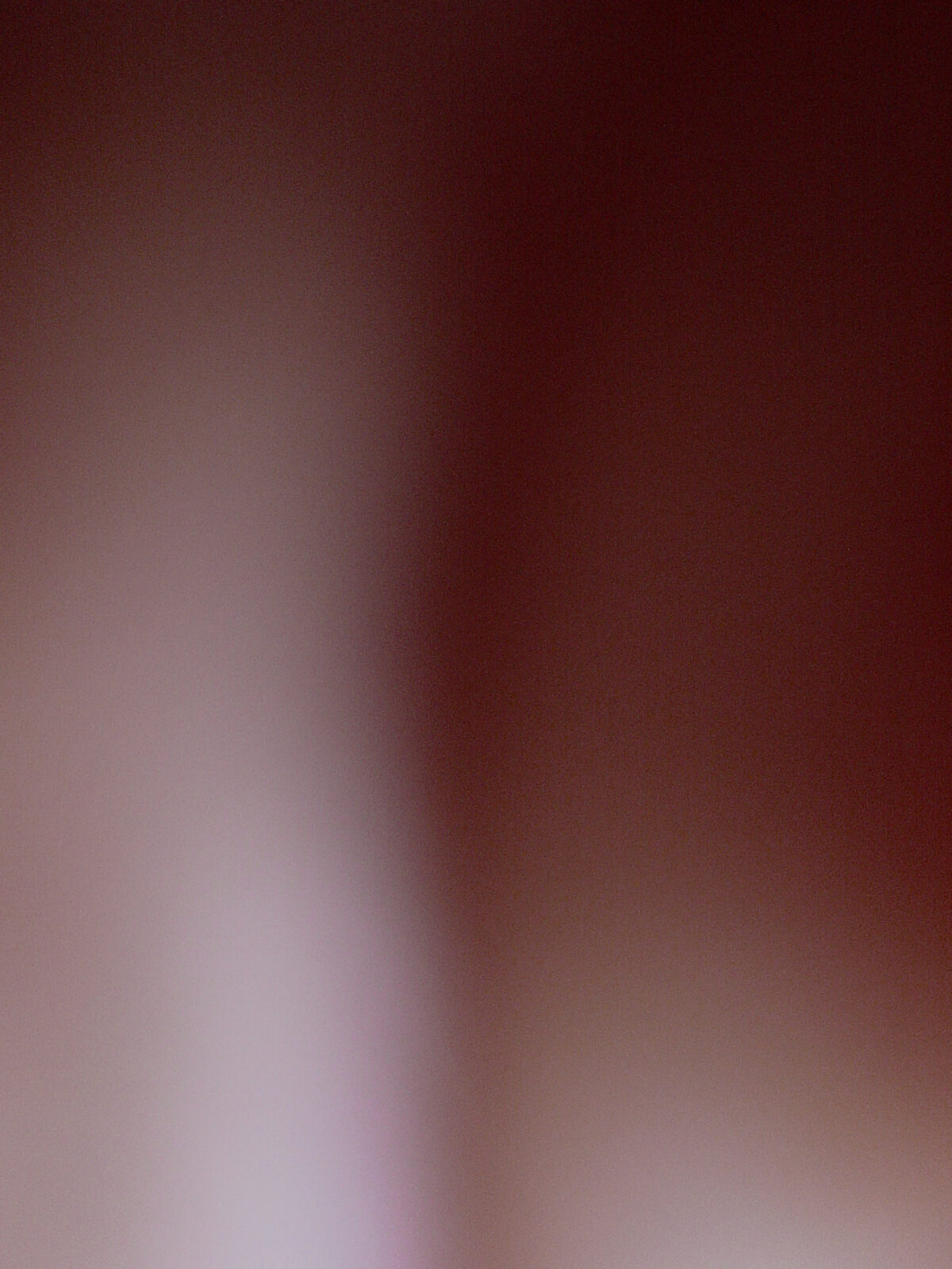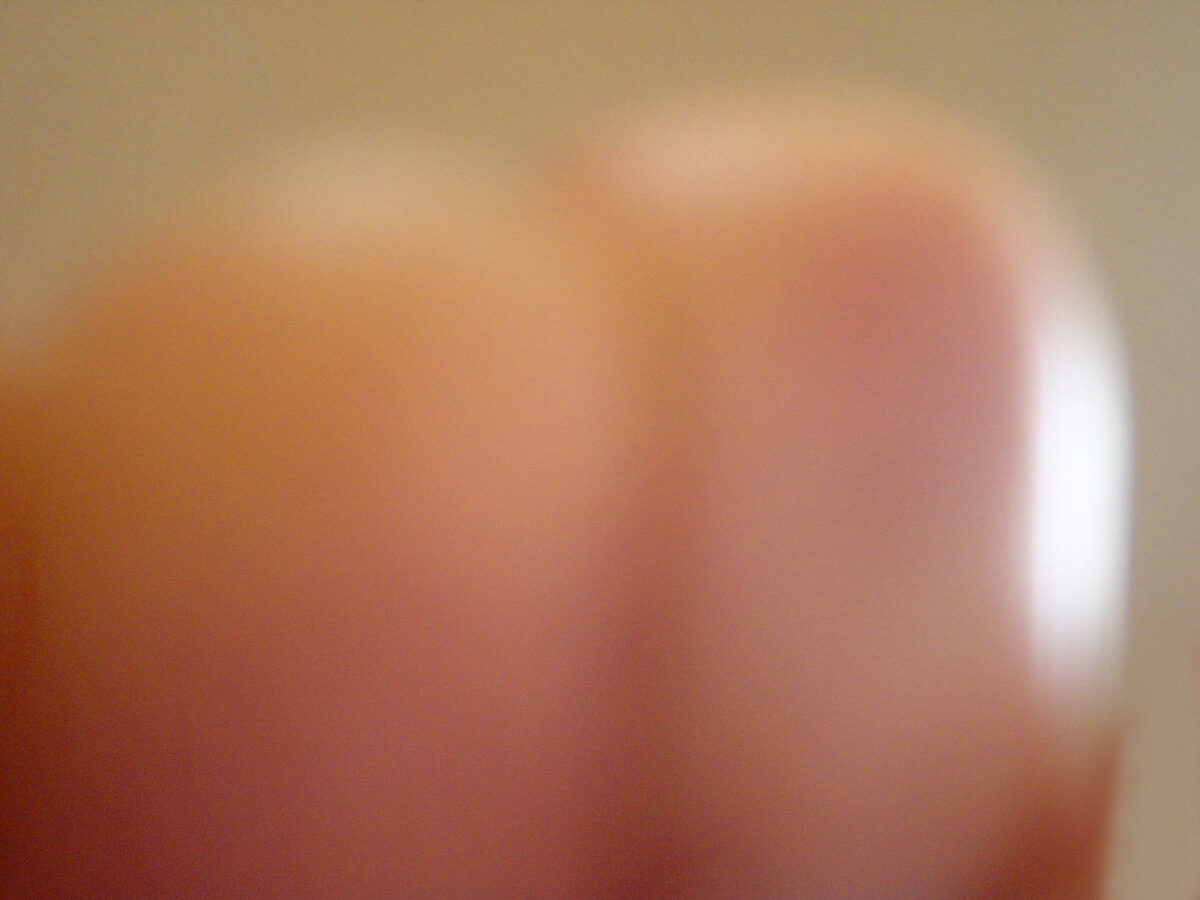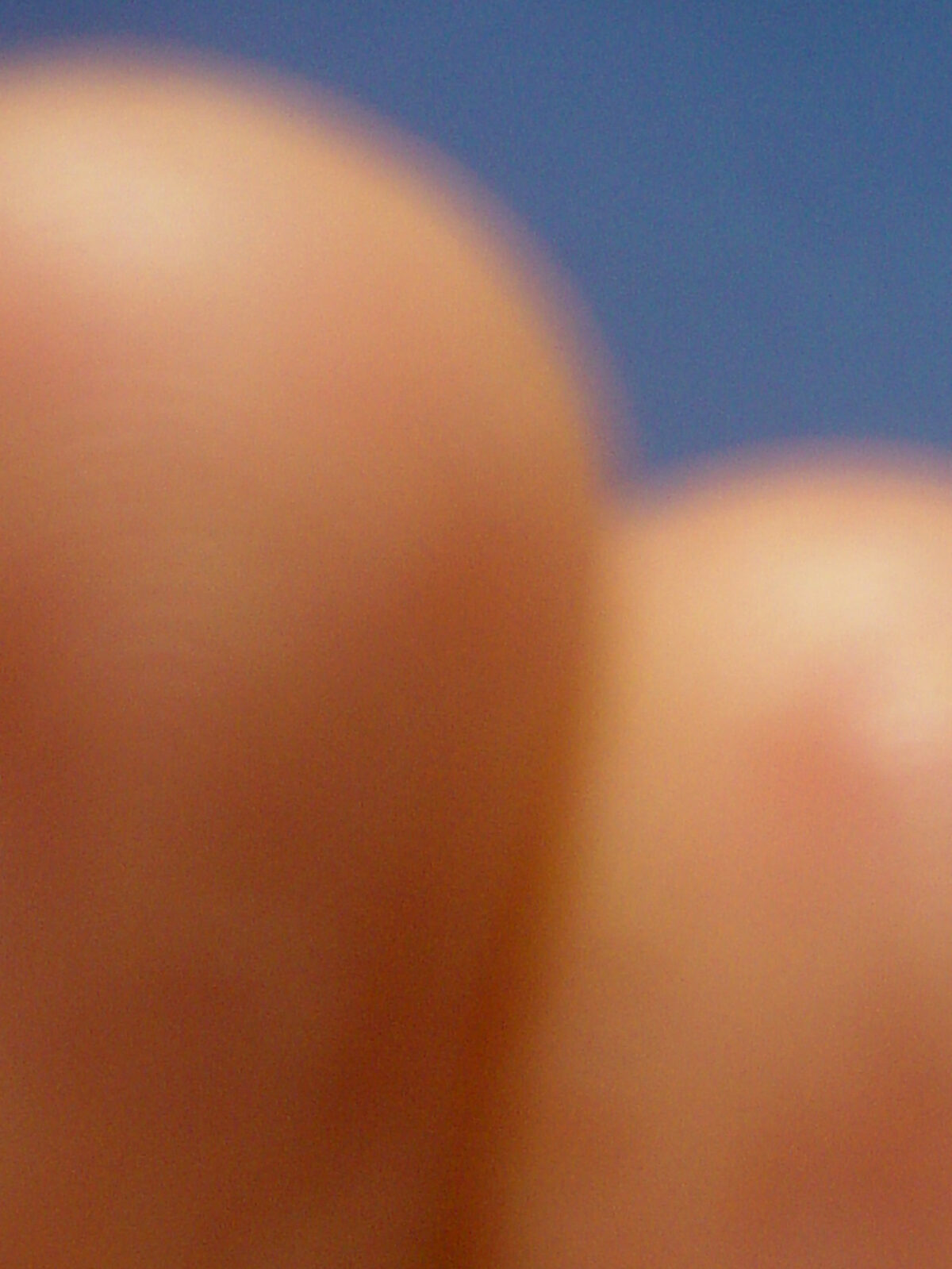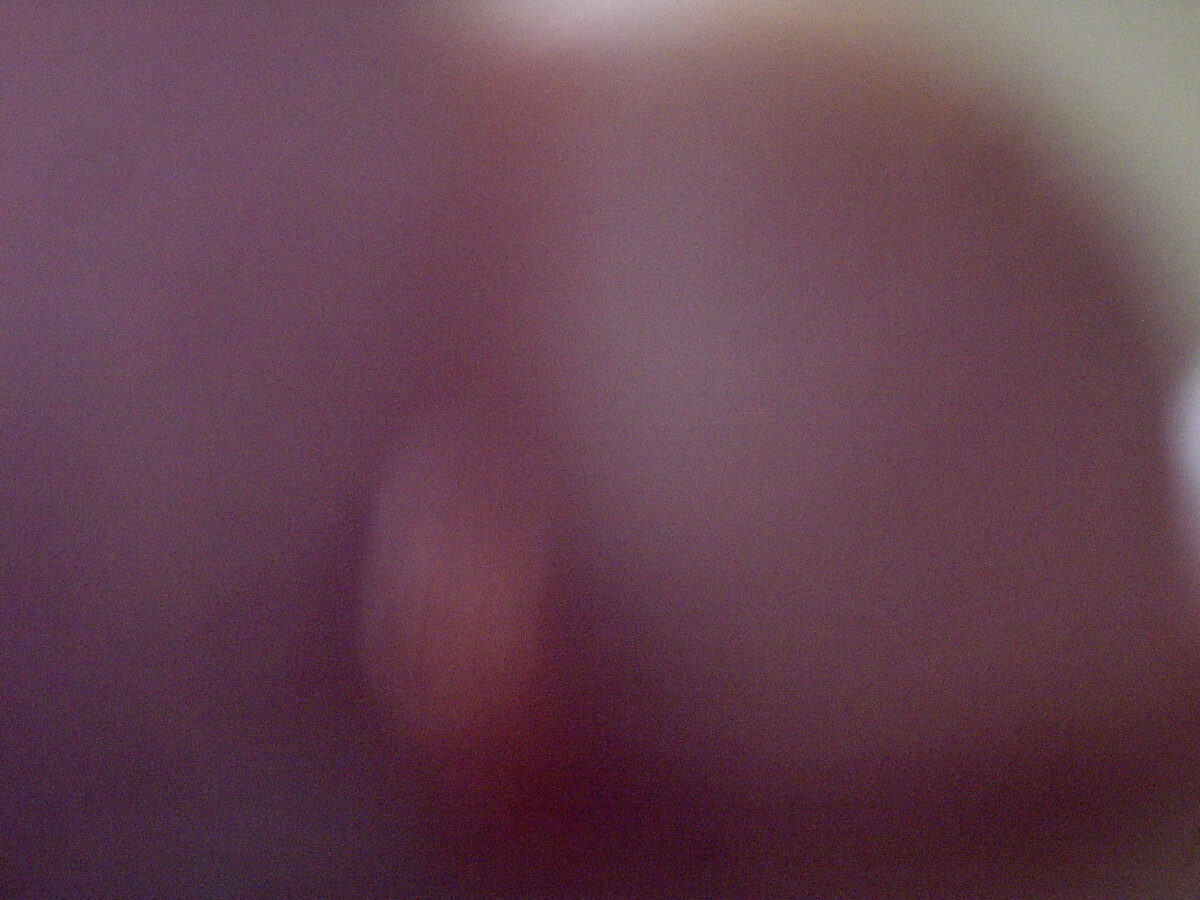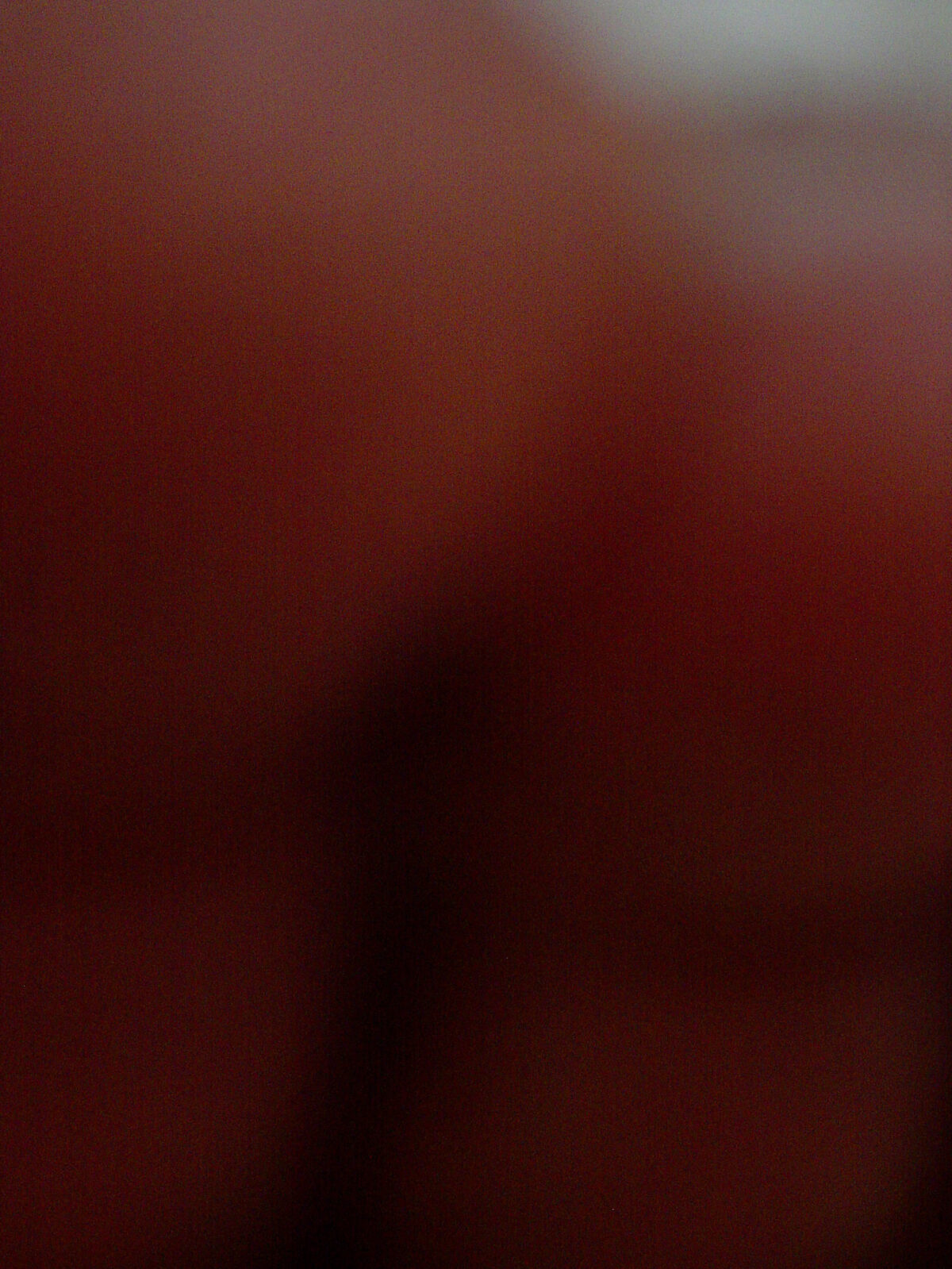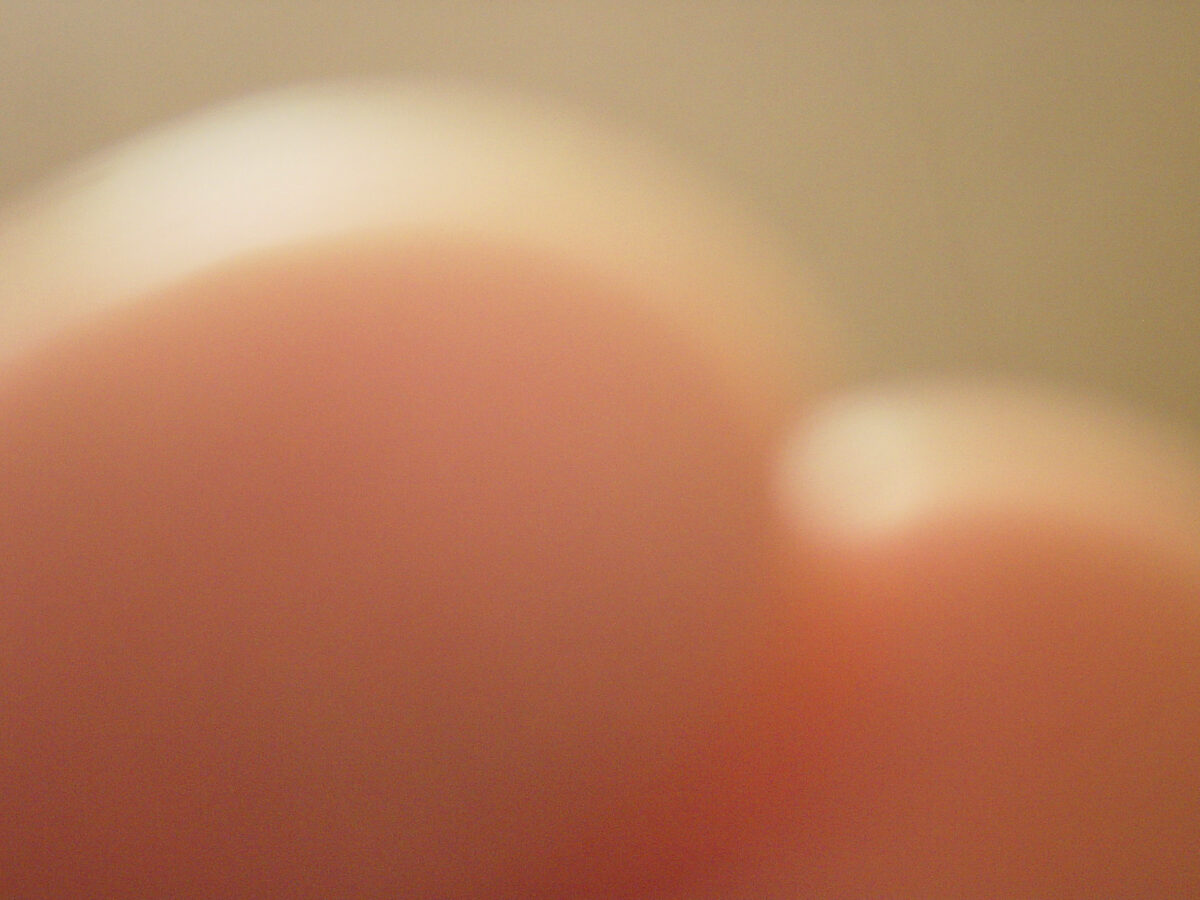Digiporn
2006
Digiporn (digitus: finger, lat.) is a series of photographs of the fingers of the artists left hand photographed by his right hand with a small digital camera in the years 2006-2008. This text summons up some thought of the artist.
Artist: Do not let your left hand know what your right hand is doing, Matthew 6:2-4.
Professor: What is Digiporn?
Artist: These are pictures that I took of my left hand with an iPhone in my right hand. The blurriness creates images of fingertips and hand folds that are reminiscent of erotic photos. Digitus means finger. Hence Digiporn, porn as finger theater.
Professor: A kind of optical illusion?
Artist: Yes. Optical illusions have always interested me. Seeing is a miracle that a blind person cannot understand. For us sighted people, it is too obvious. We are so “observant” that we never question our organ of sight. And yet appearances are deceptive and sometimes, like Doubting Thomas, it is quite wise to distrust sight and rely on older sense organs, for example the sense of touch.
Professor: The organ of sight is, in evolutionary terms, the youngest sense organ. Entogenetically, a simple protrusion of the neurodermal tube to the front. There, the cells then differentiate into light-sensitive retinal cells.
Artist: Vision is best understood through its malfunctions, blindness, optical illusions, mirages, etc. I was already interested in these topics in the 1980s.
Professor: Why is vision such an important topic?
Artist: Vision is art and art is vision. The supremacy of the eye in visual arts is a tautology. I have always been afraid of the power of the eye. Even as a child, I experienced the power of vision. I am now experiencing this again with my six-year-old daughter Anna. Daddy, I saw a ghost. Daddy, please not so dark, leave some light so I can fall asleep, etc. Drawing or taking photographs was a way for me to break the spell of the visual, even as a child. If I can represent something visually, I understand it better and have some control over it – for example pornography.
Professor: Let me put your artistic experiences on an anthropological and evolutionary theoretical basis. May I quote M.T., the leading researcher in the field of the evolution of the sensory organs? M.T. writes: “Many animals relie much more on hearing and smell and the dominance of vision seems a remarkably human invention. Let‘s have a look at its history. The development of this supremacy above earlier sensory modalities in our body and in our culture goes back to evolutionary processes long time ago. Paläntologists say it occured after the emergence of the east-african ridge some 40 million years ago. The findings of bones tell us that this huge geological crash of tectonic plates lead to a change of the climate in this for the evolution of our species important geographic area. Eastern Africa‘s vegetation turned from a humid forest landscape to a dry treeless savannah. For our ancestors this change became the challenge and chance to outrun other species. Climbing down from the trees and entering the margin between the disappearing forest and the new open space covered by high grass the hominids adapted by two in-genial changes. First they stood up. They erected themselves on their back extremities allowing them to free the forth extremities to become hands and at the same time to stick the head from the ground high up in the air. They learned to use the hands in a new way. Second they started to see. The eyes now above the grass overseeing the wage widths of the savannah became an excellent sensory equipment that would cover much more distance than the nose and the ear. The evolution of the eye, the opposition of the thumbs (that would allow tools to be used by the hand) and the mighty cerebral cortex leading finally to the use of language and thus to society distinguished the hominids to rule the savannah and the world. Yet long before that step in the east african flatland could take place the evolution of the three color retinal receptors of the eye had to take place. The evolution of the color receptors of the eye in the early vertebrates some 50 million years ago was a complicated evolutionary interaction between mammals collecting fruits and berries and the plants that carried them. The better the berries were visible in the green of the tree, the better both for the eater and for the tree, which profited being distributed well by the eating mammals. The best color for the berry is Signalrot: RAL 3001, or CMYK 0:100:100:20. This is exactrly the color we use to mark the important things: Sex and danger. Lippstick is red and the stopp sign is read. A symbiotic evolution of the eye and of the plants lead both to the red color of the fruits and the red receptor of the retina at the same time. We see red, because the strawberry and the cherry is red and vice versa. Because this evolutionary interaction was so successful the red and green contrast is so dominant in our perception. The eye and the red receptor would become the supreme sensory equipment for the early mammals for the next millions of years.”
Artist: “But what does that have to do with digiporn, with my erotic finger games?”
Professor: There is a third aspect to understand the importance of the human eye: The eye is a sexual organ. The elevation from four to two extremities led to a change of sexual behavior of the hominids. The eye again became more dominant in erotic stimulation than the nose. The primary erotic area in four-legged animals is the vulva and the buttocks and can be seen from behind. The erected two legged hominids seem to have developed an additional visual stimulus that can be seen from the front in the standing position from far away – the breast – that formally leans on the form of the buttocks in the back. The hidden vulva in the hominids lead to the the hidden ovulation, which is considered among anthropologists as a sine qua non condition for the development of complex social structures. The collaboration of males of a group of hominids was possible because they would not know when a female of the group was ovulating. This led to the development of complex sexual behaviors with a more or less constant sexual activities only loosely connected to the aim of fertilization of the female. The continuousness of sexualization was probably an important condition for the development of long lasting family structures and thus for the human protosociety. The primacy of the eye and the ubiquitary sexual determination of the brain are the main two conditions for the development of the human society.
Artist: The eye is not an objective sensory organ and just as complex as eroticism. That is why many artists enjoy using erotic images as the starting point for artistic games. I am thinking of Richard Prince, Lawrence Weiner, Thomas Ruff and Hans-Peter Feldmann, all three of whom are very clear-headed, not belly painters who abuse their penises as brushes. They work conceptually and dissect even emotionally charged images with razor-sharp precision.
Professor: The eye looks for food, sex and enemies, not for truth. It feeds us with desires and fears. The eye distorts everything to its usability: It emphasizes contrasts, simplifies visual forms to “Gestalt”, lines to the vertical of the horizon and reacts to the speed of moving objects. The world of vision is a world of optical illusions. The eye is a tool of survival, not of knowledge. We see what we are made to see. And we see sex.
Artist: The eye is an extremely dangerous organ. If your eye tempts you to do evil, pluck it out, for it is better to go to heaven with one eye…. What the eye does not see does not hurt the heart.
Professor: This Bible verse, probably from after Jesus, is interesting. Why pluck out just one eye? That would limit spatial perception in particular. But you can watch porn with one eye I suppose.
Artist: Pornography comes from the Greek word for “dirty.” Over the last few decades, pornographic motifs have conquered the Western world. Advertising uses pornographic imagery, and even in high art, the dam has burst. Lars von Trier demonstrated in his film Nymphomaniac how to destigmatize “pornographic” scenes and use them artistically.
Psychiatrist: In a few years, public displays of sexual activities will hardly cause any outrage, much like among chimpanzees or other group-living mammals. It’s likely that the retreat of eroticism into the private sphere was the real “dirty” thing. In the 1960s, the pioneers of the erotic industry saw themselves as liberators and revolutionaries challenging bourgeois rigidity with “flowers and love.” Hugh Hefner considered himself a freedom fighter against the censorship of press freedom. Today, that seems absurd.
Artist: Pornography has a similarly miserable reputation as drugs, and yet it is just as commonplace. From the “sex, drugs, and rock ‘n’ roll” of the 60s, we’re left with insipid department store music. The abstinence society is currently dominant. Sexless centenarian vegetarian non-smokers have become the societal ideal. Healthy and “natural,” they live to a ripe old age, only to spend 30 years in demented senility waiting for the end.
Even though young couples are often unhappy in their monogamous boxes and divorce rates exceed marriage rates, experimentation is out of fashion. We are still living in a deep period of restoration. Perhaps it will take some time for a new generation to follow in the footsteps of the Amden nudists or the Monte Verità anarchists at the start of the 20th century and pick up where the societal experiments of the 60s left off. Art should be the laboratory of society, not just its makeup. The world needs new experiments.
Psychiatrist: You’re a doctor, artist, theater maker, and curator. You’re best known as the propagator of Czech photographer Miroslav Tichý. You made Tichý world-famous. At the same time, you’ve withdrawn from the public eye as an artist. Since Tichý’s first exhibition in 2004, you haven’t exhibited your work in over ten years. Have you given up on yourself?
Artist: I learned from Tichý that, under certain circumstances, an artist must protect themselves from the public. Tichý couldn’t exhibit what he created. He wouldn’t have been understood or appreciated. It was wise of him to retreat into his private world and simply work in secret—for himself alone.
When I became Tichý’s curator, it was the right decision to withdraw as an artist from the public sphere. Like Tichý, I continued to work just for myself, in secret. A writer can rarely stop writing, nor a philosopher stop thinking. I love painting every day—without an audience.
Digiporn (digitus: finger, lat.) is a series of photographs of the fingers of the artists left hand photographed by his right hand with a small digital camera in the years 2006-2008. This text summons up some thought of the artist.
Artist: Do not let your left hand know what your right hand is doing, Matthew 6:2-4.
Professor: What is Digiporn?
Artist: These are pictures that I took of my left hand with an iPhone in my right hand. The blurriness creates images of fingertips and hand folds that are reminiscent of erotic photos. Digitus means finger. Hence Digiporn, porn as finger theater.
Professor: A kind of optical illusion?
Artist: Yes. Optical illusions have always interested me. Seeing is a miracle that a blind person cannot understand. For us sighted people, it is too obvious. We are so “observant” that we never question our organ of sight. And yet appearances are deceptive and sometimes, like Doubting Thomas, it is quite wise to distrust sight and rely on older sense organs, for example the sense of touch.
Professor: The organ of sight is, in evolutionary terms, the youngest sense organ. Entogenetically, a simple protrusion of the neurodermal tube to the front. There, the cells then differentiate into light-sensitive retinal cells.
Artist: Vision is best understood through its malfunctions, blindness, optical illusions, mirages, etc. I was already interested in these topics in the 1980s.
Professor: Why is vision such an important topic?
Artist: Vision is art and art is vision. The supremacy of the eye in visual arts is a tautology. I have always been afraid of the power of the eye. Even as a child, I experienced the power of vision. I am now experiencing this again with my six-year-old daughter Anna. Daddy, I saw a ghost. Daddy, please not so dark, leave some light so I can fall asleep, etc. Drawing or taking photographs was a way for me to break the spell of the visual, even as a child. If I can represent something visually, I understand it better and have some control over it – for example pornography.
Professor: Let me put your artistic experiences on an anthropological and evolutionary theoretical basis. May I quote M.T., the leading researcher in the field of the evolution of the sensory organs? M.T. writes: “Many animals relie much more on hearing and smell and the dominance of vision seems a remarkably human invention. Let‘s have a look at its history. The development of this supremacy above earlier sensory modalities in our body and in our culture goes back to evolutionary processes long time ago. Paläntologists say it occured after the emergence of the east-african ridge some 40 million years ago. The findings of bones tell us that this huge geological crash of tectonic plates lead to a change of the climate in this for the evolution of our species important geographic area. Eastern Africa‘s vegetation turned from a humid forest landscape to a dry treeless savannah. For our ancestors this change became the challenge and chance to outrun other species. Climbing down from the trees and entering the margin between the disappearing forest and the new open space covered by high grass the hominids adapted by two in-genial changes. First they stood up. They erected themselves on their back extremities allowing them to free the forth extremities to become hands and at the same time to stick the head from the ground high up in the air. They learned to use the hands in a new way. Second they started to see. The eyes now above the grass overseeing the wage widths of the savannah became an excellent sensory equipment that would cover much more distance than the nose and the ear. The evolution of the eye, the opposition of the thumbs (that would allow tools to be used by the hand) and the mighty cerebral cortex leading finally to the use of language and thus to society distinguished the hominids to rule the savannah and the world. Yet long before that step in the east african flatland could take place the evolution of the three color retinal receptors of the eye had to take place. The evolution of the color receptors of the eye in the early vertebrates some 50 million years ago was a complicated evolutionary interaction between mammals collecting fruits and berries and the plants that carried them. The better the berries were visible in the green of the tree, the better both for the eater and for the tree, which profited being distributed well by the eating mammals. The best color for the berry is Signalrot: RAL 3001, or CMYK 0:100:100:20. This is exactrly the color we use to mark the important things: Sex and danger. Lippstick is red and the stopp sign is read. A symbiotic evolution of the eye and of the plants lead both to the red color of the fruits and the red receptor of the retina at the same time. We see red, because the strawberry and the cherry is red and vice versa. Because this evolutionary interaction was so successful the red and green contrast is so dominant in our perception. The eye and the red receptor would become the supreme sensory equipment for the early mammals for the next millions of years.”
Artist: “But what does that have to do with digiporn, with my erotic finger games?”
Professor: There is a third aspect to understand the importance of the human eye: The eye is a sexual organ. The elevation from four to two extremities led to a change of sexual behavior of the hominids. The eye again became more dominant in erotic stimulation than the nose. The primary erotic area in four-legged animals is the vulva and the buttocks and can be seen from behind. The erected two legged hominids seem to have developed an additional visual stimulus that can be seen from the front in the standing position from far away – the breast – that formally leans on the form of the buttocks in the back. The hidden vulva in the hominids lead to the the hidden ovulation, which is considered among anthropologists as a sine qua non condition for the development of complex social structures. The collaboration of males of a group of hominids was possible because they would not know when a female of the group was ovulating. This led to the development of complex sexual behaviors with a more or less constant sexual activities only loosely connected to the aim of fertilization of the female. The continuousness of sexualization was probably an important condition for the development of long lasting family structures and thus for the human protosociety. The primacy of the eye and the ubiquitary sexual determination of the brain are the main two conditions for the development of the human society.
Artist: The eye is not an objective sensory organ and just as complex as eroticism. That is why many artists enjoy using erotic images as the starting point for artistic games. I am thinking of Richard Prince, Lawrence Weiner, Thomas Ruff and Hans-Peter Feldmann, all three of whom are very clear-headed, not belly painters who abuse their penises as brushes. They work conceptually and dissect even emotionally charged images with razor-sharp precision.
Professor: The eye looks for food, sex and enemies, not for truth. It feeds us with desires and fears. The eye distorts everything to its usability: It emphasizes contrasts, simplifies visual forms to “Gestalt”, lines to the vertical of the horizon and reacts to the speed of moving objects. The world of vision is a world of optical illusions. The eye is a tool of survival, not of knowledge. We see what we are made to see. And we see sex.
Artist: The eye is an extremely dangerous organ. If your eye tempts you to do evil, pluck it out, for it is better to go to heaven with one eye…. What the eye does not see does not hurt the heart.
Professor: This Bible verse, probably from after Jesus, is interesting. Why pluck out just one eye? That would limit spatial perception in particular. But you can watch porn with one eye I suppose.
Artist: Pornography comes from the Greek word for “dirty.” Over the last few decades, pornographic motifs have conquered the Western world. Advertising uses pornographic imagery, and even in high art, the dam has burst. Lars von Trier demonstrated in his film Nymphomaniac how to destigmatize “pornographic” scenes and use them artistically.
Psychiatrist: In a few years, public displays of sexual activities will hardly cause any outrage, much like among chimpanzees or other group-living mammals. It’s likely that the retreat of eroticism into the private sphere was the real “dirty” thing. In the 1960s, the pioneers of the erotic industry saw themselves as liberators and revolutionaries challenging bourgeois rigidity with “flowers and love.” Hugh Hefner considered himself a freedom fighter against the censorship of press freedom. Today, that seems absurd.
Artist: Pornography has a similarly miserable reputation as drugs, and yet it is just as commonplace. From the “sex, drugs, and rock ‘n’ roll” of the 60s, we’re left with insipid department store music. The abstinence society is currently dominant. Sexless centenarian vegetarian non-smokers have become the societal ideal. Healthy and “natural,” they live to a ripe old age, only to spend 30 years in demented senility waiting for the end.
Even though young couples are often unhappy in their monogamous boxes and divorce rates exceed marriage rates, experimentation is out of fashion. We are still living in a deep period of restoration. Perhaps it will take some time for a new generation to follow in the footsteps of the Amden nudists or the Monte Verità anarchists at the start of the 20th century and pick up where the societal experiments of the 60s left off. Art should be the laboratory of society, not just its makeup. The world needs new experiments.
Psychiatrist: You’re a doctor, artist, theater maker, and curator. You’re best known as the propagator of Czech photographer Miroslav Tichý. You made Tichý world-famous. At the same time, you’ve withdrawn from the public eye as an artist. Since Tichý’s first exhibition in 2004, you haven’t exhibited your work in over ten years. Have you given up on yourself?
Artist: I learned from Tichý that, under certain circumstances, an artist must protect themselves from the public. Tichý couldn’t exhibit what he created. He wouldn’t have been understood or appreciated. It was wise of him to retreat into his private world and simply work in secret—for himself alone.
When I became Tichý’s curator, it was the right decision to withdraw as an artist from the public sphere. Like Tichý, I continued to work just for myself, in secret. A writer can rarely stop writing, nor a philosopher stop thinking. I love painting every day—without an audience.
